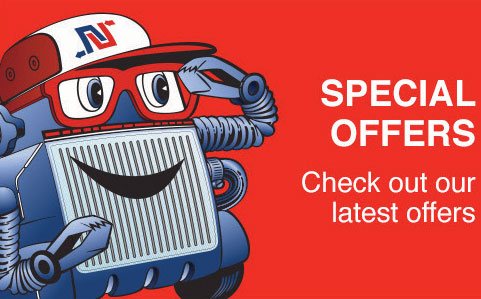How to choose the right intercooler for your car
Which intercooler is best for you?
Turbocharged and supercharged engines intake air and compress it, which creates heat. An intercooler plays an integral role in cooling down this compressed air, so the engine runs at maximum efficiency.
There are different kinds of intercoolers, and without the right information, it can be hard to work out which one will work best for your engine. That’s why we’ve uncovered everything you need to know about this engine cooling system. Read on to help narrow down the options.
Natrad has a great range of intercooler part numbers for a variety of vehicles. If you need something a bit more special, Natrad can custom make something specific to your needs.
What to look for in an intercooler
To keep things simple, we’ll start with the basic things you should keep an eye out for when choosing an intercooler.
Intercooler type
- Air to air intercooler
This is the most common in stock vehicles, as it’s a very simple system.
Its general function usually goes something like this:
- The air enters the turbocharger air intake
- It compresses the air which makes it very hot
- The air is circulated to the intercooler which then cools the air
- The cooled air is then taken to the engine
Pretty simple right? Air-to-air intercoolers are typically front mounted and rely mostly on ambient airflow from the front of the car.
Main benefits:
- Don’t have to worry about liquid leaks
- Light-weight
- Simpler system
- Cost-effective
- Unlikely to experience heat-soak if there is good airflow
- Liquid to air intercooler
A liquid to air intercooler is far more complex, but they are becoming increasingly popular in performance cars these days due to high efficiency.
Their general function looks a little something like this:
- Cool air enters turbocharger intake
- Turbocharger compresses and heats air
- This is sent into the intercooler which cools it down before entering the engine
- At the same time, coolant is also circulating through the intercooler
- The hot coolant is circulated to the radiator which sends cold coolant back to the intercooler to aid further cooling
Given there are two circuits carrying air and coolant respectively, this usually requires more accessories and fittings such as hoses.
It can be a little more on the expensive side thanks to that, but is still a highly effective system – particularly for short bursts in applications like drag racing.
Main benefits to a liquid to air intercooler:
- Highly efficient
- Efficiency can be exaggerated by using ice or other chemicals for short amounts of time
- Less turbo lag
- Can be placed anywhere in the engine bay
- Shorter routing
Mounting Location
The location of the intercooler dictates how well it may perform in your particular vehicle, and whether an air to air or liquid to air intercooler is right for you.
- Front mounted
A front mounted intercooler is often an air to air intercooler mounted in the front bumper, usually under the radiator. It relies on ambient airflow from the front of the car to go through the core and cool the compressed air running through it.
What you need to keep in mind here is that given its distance from the turbo and engine, there can be the potential for turbo lag. However, it also has direct exposure to ambient airflow so it can achieve some pretty low intake temperatures that are hard to find in other mounting positions.
- Top mounted
The top mounted intercooler placement is fairly common for stock heat exchangers — usually found on top of the engine. The airflow is supplied through a hood scoop design or some form of ducting from the front grille.
If the intercooler is top mounted, it means it won’t be subjected to road debris or clogging and damage as a result. However, it does have a higher chance of heat soak as it doesn’t have direct, unrestricted ambient airflow.
- Side mounted
Nowadays a side mounted intercooler is a pretty rare find. It can be found towards the front of the vehicle, on one side of the inlets of the bumper.
This means it pulls air from the side of the bumper, but usually isn’t a go-to for high performance vehicles in need of greater cooling capabilities.
Tank material
There are few tank options out there, such as:
- Plastic (not ideal for performance)
- Stamped (found in older turbo vehicles)
- Welded aluminium
- Cast aluminium
For the best performance and durability you should choose a welded aluminium or cast aluminium tank. Welding bonds are strong and durable, and aluminium has thicker walls to resist wear and tear.
Core configuration
Core configurations usually come in two standard choices:
- Tube and fin
- Bar and plate
There are pros and cons to both. Bar and plate cores are heavier, but sturdiers. Whereas tube and fin cores are light but more susceptible to damage.
Keep in mind that bigger is not necessarily better, there are combinations that may benefit your needs better while adhering to space restrictions within your engine bay.
Natrad makes high-quality intercoolers based on your needs, so if you’re looking for an intercooler with great performance and specific requirements, get in touch with your local store today.








